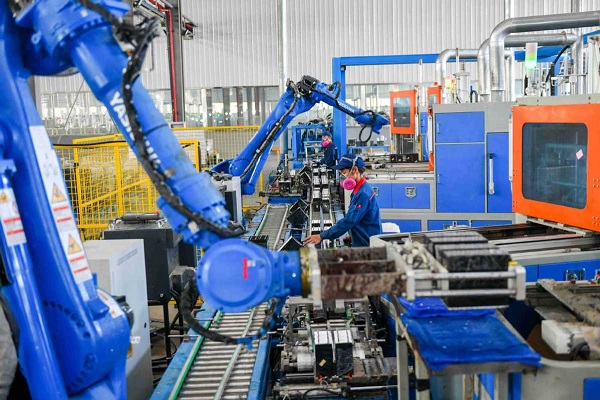Deputy calls for more efforts in green energy storage

A Tianneng employee works at a battery production facility in Huzhou, Zhejiang province. TAN YUNFENG/FOR CHINA DAILY
Stronger efforts are needed in promoting the development of the energy storage sector, with an emphasis on developing new battery types, as China demands more flexible power adjustment capacity, said a deputy to the 14th National People's Congress.
Zhang Tianren, also chairman of Chinese battery maker Tianneng Group, suggested the national legislative body encourage the development of safer and more cost-effective lead-carbon batteries and power storage stations.
He also called for encouraging technical innovation in areas of compressed air energy storage, flow batteries and sodium-ion batteries.
Zhang said: "Energy storage is a critical component of building a new energy system as China moves toward a more sustainable energy mix with renewables taking up an increasing share.
"By storing power generated from new energies for later use, the system can help solve the intermittency issue that has been a major challenge in the widespread adoption of renewables, help increase their consumption rate and reduce waste of such energies.
"The energy storage system can also enhance the power grid's peak-shaving capacity and ensure the grids' safe and stable operation when a large amount of power generated from renewables connects to the grid."
This year's Government Work Report, delivered on Sunday during the ongoing two sessions, said efforts should be made to move faster to develop a new energy system, promote the efficient and intensive use of resources, and advance energy conservation and carbon reduction in key areas.
Zhang said that the report reiterated the importance of developing a new energy system, in which energy storage plays an essential role. The report posed high requirements for battery makers like Tianneng and the company will step up efforts in research and development of lead batteries, lithium-ion batteries, hydrogen fuel cells and sodium-ion batteries, and build an industrial chain that covers the entire process from battery R&D to recycling.
Liu Yafang, an official with the National Energy Administration, said at a recent news conference that in the past year, the administration and the National Development and Reform Commission have launched a series of policies to promote the development of new types of power storage.
Liu said: "The characteristics of new energy storage complement traditional energy storage technologies, providing more options for the construction of new power systems.
"Compared with traditional pumped hydro storage, new energy storage has the advantages of flexible site selection, short construction periods, rapid and flexible responses and diverse application scenarios. It can complement pumped hydro storage and address the randomness and high volatility issues brought by the integration of new energy sources into the power system."
According to the NEA, the total installed capacity of new types of energy storage projects — other than pumped storage hydropower — reached 8.7 million kilowatts with an average power storage period of 2.1 hours last year, an increase of over 110 percent from the end of 2021.
Among those, lithium-ion battery energy storage took up 94.5 percent, compressed air energy storage was 2 percent and flow batteries accounted for 1.6 percent, the NEA said.
- Top legislature schedules session for December
- China's top legislator holds talks with president of Luxembourg parliament
- China's top legislator meets with French president
- China, Maldives pledge to enhance exchanges between legislative bodies
- Senior Chinese legislator meets Portugal's PSD delegation



